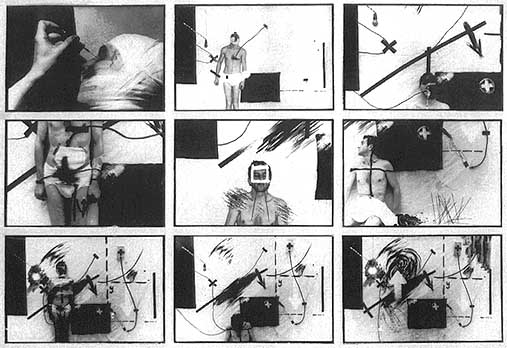
Tibor Hajas: Tumo I, 1979
John P. Jacob:
THE ENIGMA OF MEANING:
TRANSFORMING REALITY IN HUNGARIAN PHOTOGRAPHY
All the manifold tendencies in art have
as their ultimate aims to represent our new life true to reality-discarding
superficial brilliance-in works inspired by great ideas and of high moral
standard. In this, the State too, plays no small part. Not only by frequently
bestowing orders of great importance on our artists and thereby encouraging
emulation between them but also by constantly helping them to at-tain an
awareness of the essence of socialism. The imagination of ar-tists inspired
by their tasks is thus disciplined and ennobled so that it can bear fruits
of value. (1)
Faith in the evidential value of the photograph is
the foun-dation upon which the many forms of photographic practice have
been built. Not until the advent of electronic manipula-tion of photographic
imagery in popular culture of the 1970s, in fact, had the American public
seriously considered the reliability of photographic representation. In
the Soviet Union and Eastern Europe, however, the evidential value of the
photographic image is a construction which many contem-porary artists flatly
reject. If we are to comprehend their work, we must begin by foregoing
our faith in the photo-graph. We must acknowledge with them the thin skin
of ideology that holds our perception of reality, of our culture and our
history, together.
In the Soviet Union, photography has often been
used to depict the potential dis-integration or separation of reality from
its photographic representation. This potential was ex-plored in the Revolutionary
era by artists such as Alexandr Rodchenko. Rodchenko ascribed ideological
significance to the angle of the camera, believing it to possess powerful
nar-rative and symbolic associations with bourgeois tradition. He identified
the ideological function of art and, by harnessing it, sought to define
revolutionary perspective. “The revolu-tion does not consist in photographing
workers' leaders in-stead of generals while using the same photographic
techni-ques as under the old regime, or under the influence of Western
art,” he wrote. “A worker photographed like Christ, a woman worker photographed
like the Virgin Mary, is no revolution... We must find a new aesthetic...to
represent the facts of socialism in terms of photography.” (2)
By 1930, in the leading article of the first issue
of “USSR in Construction,” ideologues were demanding that “photography
must serve the country not in a haphazard, un-systematic way, but constantly
and according to a plan.” (3) Thereafter, Soviet photographers joined increasingly
with the press. “[Soviet] photography passed through years of seek-ing
and struggling, of chaos, misunderstanding and mistakes before finally
maturing as the powerful medium of photo-journalism, which continues to
perform the functions defined for it from the outset: to inform, disseminate
and educate.” (4)
In the 1930s many of the practitioners of the experimental
New Vision found themselves and their work subject to increasing critical
scrutiny. As the experimental period came to a close in the Soviet Union,
the photograph, like all other forms of visual expression, came under State
control. Like many other artists, Rodchenko was condemned for his “formalism.”
In 1931 Rodchenko was charged with “attempting to put proletarian art on
the path of Western advertisement art, formalism and aesthetic.” (5) In
the end, anti-formalist critics crushed artistic experimentation by declaring
its failure to satisfy the ideological requirements of revolutionary society.
Thereafter, cultural uniformity under the control of the State was ruthlessly
enforced.
In 1934 at the First All Union Congress of Soviet
Writers, Socialist Realism was ratified as “the only artistic style acceptable
to a Socialist society.” (6) This declaration rendered all forms of artistic
experimentation, formalist tendencies, or Western influence in any field
of creative expression essentially anti-Socialist and therefore illegal.
Following the ratification of Socialist Realism, photo-journalism became
(and to-day remains) the dominant trend in Soviet and Eastern European
photography.
Despite imposed limitations, it has fallen to the
artists of these nations to speak as the “voice-of-the-people.” Traditionally,
this position has been held by poets, whose gift could be discreetly transported
and freely shared. Following the thaw of the late 1950s in the Khrushchev
era, restrictions on visual artists were significantly relaxed. Communication
between East and West improved, and international travel became a possibility.
During this period especially, visual ar-tists began to break with the
doctrine of Socialist Realism and to adopt critical positions in their
work. This break from Realism was seen by many as an attempt to return
to realism. Such a return could be effected only by the complete dismantl-ing
of Socialist Realist aesthetics and of the structures that support them.
A dismantling of this magnitude, however (necessarily taking into account
all forms of ideological production, including the printed and electronic
media), remains impossible.
Today the aesthetic of Socialist Realism is rejected
for its failure to acknowledge the rich cultural traditions shared by the
nations of Central Europe. In dismissing the enforced Soviet aesthetic,
artists are rejecting “Eastern Europeanness” in favor of a pre-Warsaw Pact,
nationalist self-identification (nationalism is itself a primary taboo,
indicating in a work of art its maker's relation to Sovietization).
In the present political and cultural situation, Hungary is considered
the most stable and consistently liberal of the Soviet bloc nations. Political
progress has been made slowly in Hungary since the Revolution of 1956.
To achieve the goal of socialist democracy, the Hungarian Socialist Workers'
Party (HSWP) has gradually recognized a plurality of voices within the
fields of culture and politics, providing the working classes (including
cultural workers) with a role in the exercise of power. By listening to
dissenting voices, and by incorporating their ideas into the party program,
the HSWP has proposed to regain legitimate authority in the eyes of the
working people. As János Kádár declared in 1980, “our most important method
is persuasion, and not ordering people about.” (7)
Today, artists in Hungary are considered full members
of the socialist State and participate in the construction of socialist
democracy. The artist need not be a member of the party, only a responsible
citizen whose work performs a relevant task, as determined by the various
ministries, within the socialist structure. The Hungarian artist is offered
a role in the exercise of power by creating work that will help the State
to grow; the artist becomes a “cultural director” in a system of directed
culture. In compensation, he or she is rewarded with the resources to continue
such work.
It has been said that the arts in Hungary have “opened up,” that they
have transcended the boundaries imposed by Socialist Realism. Yet, until
very recently, the arts have opened to diversity largely to the extent
that they show their appreciation of socialism. “The characteristic features
of the past thirty years are a readiness to accept things, the presumption
of good intentions and understanding,” declared István Katona, a former
leading member of the Central Committee of the HSWP, “as long as no one
takes action against the socialist system and its political foundations.”
(8) According to György Aczél, a member of the Hungarian Politburo and
head of the Institute of Social Sciences of the HSWP, “there is no opposition
that has to be reckoned with in Hungary... there is no censorship in our
country.” (9) The HSWP has traditionally regarded oppositional criticism
as coming from “maladjusted, untalented, mentally troubled and/or disappointed
people who never blame themselves but always society,'' (10) and whose
opinions are not worthy of attention. If what they have to say has any
connection with reality, it is strictly by chance.
Hungarian audiences have long been protected from
any influence that might be considered harmful through State control of
all cultural institutions. Despite the relaxing of restrictions in recent
years, experimental artists are still regarded with suspicion in Hungary
and throughout Eastern Europe. Until approved by party cultural officials,
experimental work is regarded as having more in common with Western than
with home interests. Vanguard Hungarian artists are rarely prevented from
working; they support themselves with nonartistic jobs, the materials they
require are generally available, and they are free to pursue their artistic
interests in their homes. Nevertheless, few exhibition or publication opportunities
exist for them in their own nation. They cannot complain that their work
is censored, only that it is not seen. The artist who chooses to work outside
the system of State direction is thus denied the possibility of performing
a social function.
Until very recently, all experimental artists in
Eastern Europe and the Soviet Union constituted a parallel culture, an
unofficial culture that never intersected with official, or Statesanctioned,
culture. (11) In the past, developments in parallel culture within these
nations have tended to occur in relative isolation; artists in Poland,
for instance, often knew as little as Western Europeans and Americans did
about artists working in Hungary. Whereas Western perception has tended
to regard Eastern Europe as unified and monolithic, in fact, these nations
are profoundly divided.
Even in the most difficult years, Hungary has long
been regarded as a gateway between Eastern and Western Europe. Much more
than several of its neighbors, Hungary has had access to information about
developments in the West. Even when Western styles were condemned and when
artists who incorporated Western ideas into their work were unable to exhibit
or to publish, developments in foreign culture were part of the Hungarian
cultural dialogue. In contrast to the situation in the West, however, a
marketplace has never ex-isted for Hungarian art.
Only one “independent” gallery exists for exhibitions
of Hungary's young experimental artists. The Liget Galéria in Budapest
has been open for six years under the directorship of Tibor Várnagy. Funding
for the Liget comes from the leaders of the district of Budapest in which
it is located. They receive funds directly from the State to use as they
deem appropriate. The situation is somewhat unusual in that funding for
culture is usually provided by the Hungarian Ministry of Culture. As the
economic situation in Hungary has decayed, however, funding has disappeared
for all but Hungary's largest cultural institutions, with the result that
independent galleries have been forced to close their doors. Only the Liget,
its source of revenue undiminished, has survived.
Under Várnagy's leadership, the agenda of the Liget
has proven somewhat enigmatic. Together with Marek
Grygiel, director of Warsaw's Mala Galeria, and Dr.
Gerlinde Schrammel, director of the Fotogalerie Wien, Várnagy has arranged
for exchanges of exhibitions between Hungary, Poland, and Austria. Since
1986 the Liget has hosted exhibitions by such diverse international artists
as Milan Knízák (Czechoslovakia), Kirsten Thomas Delholm (Denmark), and
Hermann Nitsch (Austria). Programs have ranged from exhibitions to performance
art and video, to poetry readings and concerts. Within the confines of
the Liget, Várnagy has constructed an astonishing dialogue between artists
of many cultures; each exhibition appears to build upon the one that preceded
it.
Without the demand for novelty that a marketplace tends to create,
Hungarian artists have been more or less free to develop their ideas privately,
incorporating elements from their own culture as well as from others. The
enforced privacy of their production grants them the freedom to work and
re-work an idea over prolonged periods, which is quite unusual to those
familiar with the relentless trendsetting of Western, particularly American,
art. Increasing opportunities for Hungarians to participate in an international
artworld is simultaneously a welcome and intimidating new element in the
lives of many artists. It is a situation that the Liget Galéria has helped
artists to cope with, encouraging them to main-tain the Hungarianness of
their work by providing them with an athome space in which to develop,
and by offering examples of related experiments from beyond the Hungarian
borders.
The artists in the present exhibition are related
far more by the Hungarianness of their works than by their relationship
to the Liget. As a whole, their work is indicative of a Hungarian photographic
tradition largely unknown in Hungary before the 1960s, informed by the
images and ideas of Hungarian émigrés, such as André Kertész and László
Moholy-Nagy. From Kertész these artists have learned the tradition of the
Subjective photograph, which developed extensively in the post-World-War-II
photography of Western Europe and the United States, but was forbidden
in the East. From Moholy-Nagy, they have learned how to transcend the simple
making of pictures in order to develop suggestive visual forms, and how
to explore the potential of their materials, a significant skill in times
when equipment and/or materials are scarce. From both Kertész and Moholy-Nagy,
as well as from the likes of Brassai, Kepes, and Munkácsy, Hungarian artists
have gained the pride of knowing that many signifi-cant developments of
twentieth-century photography have been determined by Hungarian artists.
As deeply rooted in a buried Hungarian culture as
these works are, they are simultaneously informed by Socialist Realism,
both in their use and rejection of its restrictions. The photographers
in this exhibition do not accept the value of the photograph as evidence.
In their images reality is either absent or is presented as absurd. The
truth that they offer is unyielding. Deeply personal to the point of obscurity,
these images refuse to be defined by the terms of an officially sanctioned
reality.
The relationship of these photographs to Western Conceptualism is also
abstruse. In 1976 László Beke charted this rela-tionship, listing “radically
new principles” in photographic production as having been anticipated by
Hungarian artists of the 1960s:
What have these new principles been? The following
issues came in-to the light: The relationship of reality and artistic reality,
the setting and expanding of the borders of art, the nature of the epistemological
and social function of art. To what degree can the “picture” of reality
be identified with reality... Is art entitled to deal with subjects “strange
to its genre” like e.g. time? (The representation of processes, the depiction
of momentary events.) Can a “picture” intervene in reali-ty itself?...
Starting from the undoubtable social role of mass com-munication media:
can art make use of these media? If so, what are these media in fact? How
does art itself behave as a medium? (12)
Conceptualism offered Hungarian artists the development of highly private
forms of visual language, obscure to the cen-sors yet highly readable to
their intended audience. Thus a form of Conceptualism dealing explicitly
with the relationship of the artist to institutions of power, a distinct
precursor to American post-modern photography, has flourished in the work
of Eastern European photographers. Similar in appearance to much Western
photographic Conceptualism,
this work often incorporates elements from performance art. However
it possesses little of the humor of American artists such as Hollis Frampton,
whose photographic works poked fun at the assumed veracity of scientific
uses of the medium. Rather, Hungarian Conceptualism' is more closely related
to European Action art, such as the work of Hermann Nitsch, Joseph Beuys,
and Milan Knízák.

Tibor Hajas: Tumo I, 1979
Action art has continued as a viable form of expression in Eastern Europe.
The collaborative photographs of Tibor Hajas
and János Vetö made during the 1970s, for example, offer a profoundly disturbing
response to the restrictions of official culture. The first of nine photographs
in the series “Tumo I” presents a close-up of Hajas, his face burned
and wrapped in gauze, inserting a syringe into his eye. In other images
his wrists and genitals appear to be electrically wired, and long needles
are inserted into his nose. The backdrop of the photograph, from which
Hajas has disappeared in the final frame, presents a mass of Constructivist-like
forms, abstracted from their historical context. The corrupted forms, like
the mutilated body, have become useless signifiers. In similar works Hajas
is shown tied and suspended, standing with his genitals exposed over flames,
and masturbating while explosives ignite nearby.
Language has historically formed the foundation
of Hungarian selfdefinition, and until the nineteenth century Hungarian
culture was largely language-based. Unique to the artists in this exhibition,
however, is their use of the photographic medium to reveal the failure
of language. If reality is constructed through ordering (visual or verbal)
language, and if, through language, reality (history, cultural order) has
been conscripted into foreign service and falsified, then language must
be understood as having failed its people.
As much as the works in this exhibition are indicative
of a dissatisfaction with the situation in Hungary in general, and with
the role of culture in specific, they expose a distinctly optimistic element
combined with melancholy. In revealing the failure of language, the last
vestige of traditional culture, this Hungarian photography has abjured
its long relationship with the social representations of Socialist Realism
in order to address deeply felt spiritual needs. A new kind of order, the
private order of a spirituality that predates cultural history, has emerged.
The photographs of Lenke Szilágyi emerge
from the profound rupture in contemporary Hungarian photographic discourse
between social reportage, much of which descends directly from the aesthetic
of Socialist Realism, and Subjective photography. In contrast to the social
orientation of reportage, the Subjective photograph focuses upon the individual
and the search for an inner truth. The development of a subjective style
of photography in Western Europe and the United States after the Second
World War was not followed in Eastern Europe. Socialist Realism imposed
the truth of Socialist society over the truth of the individual in the
Soviet Union and Eastern Europe. Individualism, regarded as an implicitly
corrupt remnant of Western influence, was prohibited. During the thaw of
the 1960s the Subjective photograph appeared among other oppositional forms
in Hungarian photography.
Szilágyi's photographs are reminiscent of the earliest
photographs of Kertész, made in Hungary shortly before he emigrated to
Paris. Her images descend directly from the tradition of the “decisive
moment,” established by Kertész and Cartier-Bresson after him. What characterizes
Szilágyi's photographs, and differentiates her work from the work of her
predecessors, is the artist's refusal to provide a single, distinct subject
within the photographic frame. Immediately appealing in their realism,
Szilágyi's photographs are also ex-traordinarily disorienting.
In each of the photographs of the series “Sunday's
Photo-graphs” the landscape, more than the figures within it, dominates
the image. The figure of the artist appears in several photographs, in
which she seems to wish to merge with the vegetation. In one the silhouetted
figure's head has become a leafy branch. In another the figure lies in
a foetal crouch in dense vegetation. In the last, the figure rests on the
broken branch of a tree, looking out at the smoke-covered city below. Photographs
in which the artist is not present show figures framed by their natural
environment, yet always distinct or isolated from it. It is their clothing
or their games, or the photograph itself, to which these figures belong.
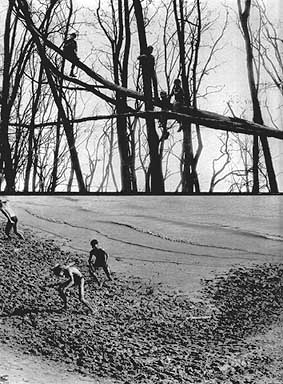
There is a potent melancholy to Szilágyi's photographs.
They speak clearly of the artist's isolation from nature and of her alienation
from culture. Perhaps the most telling image in the series is a selfportrait
of the artist sitting alone on a plain bench in a stark room. The artist
looks at a chicken that is eating from the floor. A window at the side
of the room is sealed. Where other photographs in the series suggest the
dislocation of the figure within his or her natural surroundings, this
image depicts the absolute containment of nature by culture, and of the
artist as central to it.
Minor White, an early proponent of Subjective photography in the United
States, defined the inner search characteristic of the style by declaring
that “ever since the beginning, the camera points to myself.” In Szilágyi's
photographs this inner search is undermined by the trappings of culture,
which has come to use and define nature for its own purposes. Szilágyi's
camera points to the absence of self, the impossibility of inner truth
in a world where natural order has been subsumed by cultural order.
“The Great Fehérvár Flood” is the collaborative
project of László 2. Hegedüs and László Lugosi-Lugó. Hegedüs is a graphic
artist who has worked ex-tensively with film and photography. Lugosi-Lugó
is a documentary photographer. With his wife, Aljona Frankl, he
has worked for years documenting various elements of con-temporary
Hungarian culture. In the “Shops Series” Frankl and Lugosi-Lugó
recorded the growth and decay of the “Hungarian economic miracle,”
the privatization of small shops to stimulate the economy. Simultaneously,
Lugosi-Lugó has documented the gradual disappearance of elaborate neon
signs, constructed in the 1950s, from the streets of Budapest as the face
of the city changes.
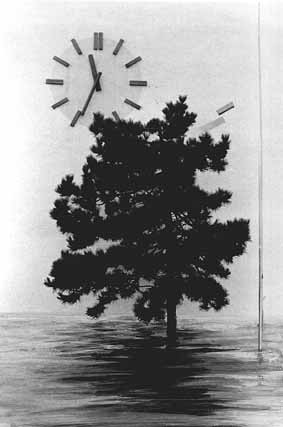
László 2 Hegedüs: Untitled from the series
"The Great Fehérvár Flood" (1989)
Fehérvár is a small city south of Budapest. Its distinctive
old town center has been beautifully reconstructed, whereas countless nondescript
concrete high-rise buildings line its outskirts. The city is at once the
site of tourism and the home base of the Soviet occupational forces in
Hungary; it is, in other words, a site of conflict. There is no river or
sea near by that could possibly cause flooding. “The Great Fehérvár
Flood” is an elaborate fantasy. It presents the dual possibilities
of an indiscriminate washing away of post-war culture and a much needed
cleansing of the debilitated Hungarian soul.
“The Great Fehérvár Flood” is a powerful
incrimination of the imposition of Socialist Realism on all aspects of
Hungarian culture, and of that culture's disappearance behind the facade
of reconstruction. Beautiful as it may be, the reconstructed city center
is no different from the highrise workers' housing in these photographs.
It is less a tribute to Hungarian architectural tradition (most of which,
after all, reflects the cultures that have dominated Hungary) than to the
wisdom of the Central Committee who recognized in the city a stopover for
tourists on their way to Lake Balaton. The flood washes away the history
of Hungary's domination, the ideological landscape, from official buildings
and workers' housing to private shops and monuments to the Liberation.
Its rising waters hint at the possibility of a rebirth of Hungarian culture.
Zsigmond Károlyi's untitled series offers his audience
quite a different view of Hungarian reconstruction. As in so many Eastern
European cities, post-war reconstruction has been slow to occur in Hungary,
and hous-ing is poorly maintained. Many of Budapest's old buildings are
suspended in scaffolding, much of it quite old. In Károlyí s photographs
these wooden structures offer dual significance. Hand painted onto the
photographic paper using old or poor photo-chemicals, the images appear
to be physically disappearing from the edges of the print as much as they
are, in fact, chemically decaying on its surface. Károlyí s scaffolding
is a none-too-subtle indictment of the Socialist regimé s failure to live
up to its promises.
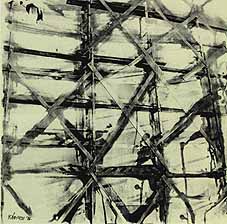
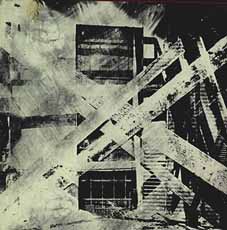
Zsigmond Károlyi: From Scaffold Series # 14, 8
On a very different level, Károlyi's photographs
indicate the frailty of the remnants of Hungarian culture. In speaking
about the geometric “X” motif in his photographs, the artist gestured
at the scaffolding that holds up the inside walls of his studio. These
structures, hidden from the view of the public, support the room in which
the artist has lived and worked; without them the walls would quickly weaken
and fall. Like “The Great Fehérvár Flood” Károlyi's photographs
speak of the disappearance of Hungarian culture behind the facade of reconstruction.
Further, Károlyi questions what would remain following the dissolution
of imposed culture. Frail as they may be, these structures support the
artist's work. Prophetically Károlyi poses the question now plaguing Hungarian
political reformists: With what shall we replace that which is all we know?
Károlyi's photographs speak of the interior definition
of the artist by exterior forces, of the struggle to find a voice of one's
own in circumstances where the only known language supports a decaying
structure. The photographs of István Halas reveal a similar struggle. Using
only photographs made inside his small studio, Halas combines fourteen
negatives in each of the four photographs that make up the individual “Sonnets”
in the series “Sonnets I-V.” In this series, Halas speaks eloquently
of the artist's difficulty in finding a place within the structures of
Hungarian culture without perpetuating its terminology.
Like Károlyi, Halas was trained as a painter.
His work with photography has fluctuated from portraiture to landscape
to “interior landscape,” using both color and black and white. His
earlier work with portraiture and land-scape was distinctly influenced
by Western photographic trends. In his minimalistic landscapes, Halas attempted
to bridge cultures using unifying elements from the architecture of different
European and American cities. Halas' work with photographic tableaux, of
which “Sonnets I-V” is the most recent series, represents a retreat
from his earlier efforts.
Sonnet 1 depicts a photocopy of a portrait of Robert Frank by
Richard Avedon, one of many images hanging in Halas' studio. The photograph
is significant in its representation of two artists whose radically different
approaches to photography have greatly influenced Halas' earlier work.
Here it signals a departure both from the influence of these artists and,
by extension, from the dicta of Western photographic trends.
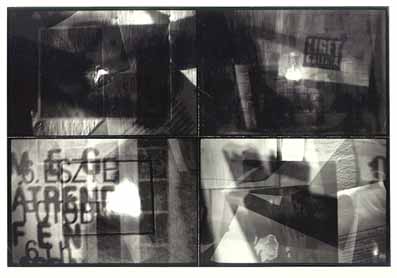
In Sonnet II crumpled paper and cigarettes
lie on the studio floor. The graphic image of an umbrella, used in a collaborative
film of Halas and László 2. Hegedüs, and a pin commemorating the Polish
Trade Union Solidarity appear, as does a wall label used in an earlier
exhibition of Halas' work. In Sonnet III, the black frame of a single
photographic image is obscured by the text of a poster from the Esztergom
Foto Biennial. Sonnet III also contains an earlier work, a simpler
tableau of four photographs of the stairwell to Halas' studio. In the fourth
and final image, a glowing lightbulb is montaged with the insignia of the
Liget Galéria taken from a poster designed by the artist. Behind the bulb
and the insignia looms the first of Halas' complex tableaux, made in 1986.
This early work encapsulates the history of Halas' development as a photographic
artist, beginning with his first and ending with his most recent image.
Sonnet IV and Sonnet V return the
viewer to the objects of the artist's studio. A copy of the catalogue Bilder
recalls the exhibition of Hungarian photographers at the Photogalerie Wien
in which Halas' tableaux made their first public appearance. The outline
of a hand obscures the image of a single--frame photograph and the form
of a long strip of film overshadows a pile of prints. Finally, the word
“zenit” (zenith) emerges, suggesting that the artist has found, within
the confines of his studio, his own voice.
In “Sonnets I-V,” Halas presents a series
of juxtaposing signs that show the crosscurrents of his life as an artist.
His photographs are distinctly selfreferrential; the artist speaks only
for himself. He confines himself to his studio, but that small space is
filled with signs from the outside. “Sonnets I-V” is a dialogue
of signs, many of which are but notes by the artist to himself; they are
the origins of a private language and, as such, offer little information
to the viewer. It is in the juxtaposition of these private signs with others
from the outside that the viewer is encouraged not so much to understand
the artist, to seek reassurance in his images, as to engage in the dense
visual process that he has begun. The photocopied Avedon portrait represents
a removal from the sleek, formal surfaces and highly public life of one
artist (Avedon) to the obscure meaning, damaged surfaces, and highly reclusive
life of the other (Frank). At least a fourth-generation copy of the original
and rephotographed by Halas only in pieces, the photocopied portrait depicts
a physical tearing away of the image from its context in reality, from
cultural order. The glossy poster from the Esztergom Foto Biennial, a place
where conformity to genre and institutionalized practice are encouraged
and rewarded, is juxtaposed to the insignia of the Liget Galéria, where
the development of the private language of the artist, as free from influence
as it is free to appropriate the terms of influence, is encouraged.
Halas' photographs speak of the search for self
through the subversion of meaning in visual forms. Like Zsigmond Károlyi,
he presents a response to official culture while recognizing that the work
of the artist, particularly if it is to achieve public response and support,
must always be deeply rooted in its terminology. The terminology by which
the ar-tist is defined in the photographs of Zsuzsanna Ujj are, by contrast,
archaic. They are the signs of an imposed cultural order that far predates
the Hungarian Liberation.
Ujj is a poet, performer, musician, and visual artist
who works exclusively outside the Hungarian system of directed culture.
She is one of the few Hungarian artists who continues to link performance,
Action art, and photography. Exhibitions of her photographs have often
been accompanied by performances and documentation.
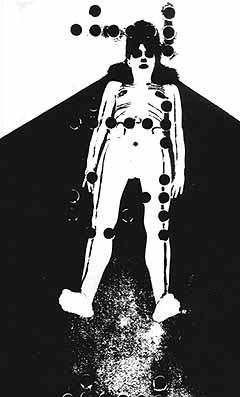 Ujj’s work deals powerfully with the cultural representation of gender,
the power of sexuality, and, ultimately, with the dual relationship of
sex to death and of representation to violence. In one photograph, the
artist sits upon a fabricdraped chair that rests on a platform. Her body
is painted to emphasize her eyes, mouth, breasts, and vagina. Her position,
looking down at the camera, is one of power. A second image shows the painted
body swooping down upon the viewer. Her arms and legs disappear into the
black background. Her mouth is open as if in a scream, her look menacing,
devouring. In the third image of the series, the artist stands with the
figure of Death. Death is a man in a dark suit; the artist’s hand rests
provocatively on his leg.
Ujj’s work deals powerfully with the cultural representation of gender,
the power of sexuality, and, ultimately, with the dual relationship of
sex to death and of representation to violence. In one photograph, the
artist sits upon a fabricdraped chair that rests on a platform. Her body
is painted to emphasize her eyes, mouth, breasts, and vagina. Her position,
looking down at the camera, is one of power. A second image shows the painted
body swooping down upon the viewer. Her arms and legs disappear into the
black background. Her mouth is open as if in a scream, her look menacing,
devouring. In the third image of the series, the artist stands with the
figure of Death. Death is a man in a dark suit; the artist’s hand rests
provocatively on his leg.
Ujj’s poses in her photographs are often reminiscent
of prehistoric figurines of the Goddesses of Fertility. Such figurines
are thought to have commemorated the relation of the fertility of women
to nature, and to “give magical aid in childbirth and conception.” (13)
In her earliest representations, the Goddess was depicted as the source
of life, and intercourse with her the source of knowledge; like nature
itself, she was untamed. In the course of history, however, nature came
in-creasingly to serve the needs of man and reproduction became an integral
part of his economic development. (14) The role of women, and with it the
perception of the Goddess, changed.
Artemis-Diana, once the wild mother of vegetation...was
rendered chaste and frigid, she was made into a virgin. She no longer fetched
men into her womb, but rather struggled against those who pursued her in
order to watch her bathe in the nude. Later on this Diana was compared
with the Virgin Mary...Intercourse was less and less knowledge, it developed
into a menace. The vagina acquired teeth. It ate and devoured. (15)
Like Halas, Ujj makes photographs that are selfreferential.
The setting of her photographs is always an anonymous space within which
darkness encroaches from all sides, reminiscent of the caves in which Goddess
rituals were performed. In one photograph, a bright light illuminates and
beckons the viewer to her womb. In the next, her blurred and bleeding figure
appears in pain (fig.10). In the final image, a horrible, bloody mass emerges
from her. In these images, Ujj represents a powerful Goddess whose sexuality
must be feared. The Goddess is no longer connected with nature, nor does
she bear any relationship to the Virgin.
Ujj's photographs struggle against the historical
violence of the representation of women by focusing on sexuality as an
imposed cultural construction. Through a series of con-frontational poses
directed at the viewer, recognizable through their appropriation of sexual
symbols, Ujj undermines her audience's “innocent gaze.” To strike a pose,
as Dick Heb-dige has written, is to pose a threat. The anonymous space
of the Ujj's photographs extends to the space of the gallery or museum;
the threat of her pose extends to the viewer within it. Returning the gaze
of the viewer Ujj defies the borders of the print. Her photographs transform
the gallery, and with it the tradition of the passive female nude that
it represents, into a site of confrontation.
János Vető's photographic constructions,
like those of István Halas, are unyielding and enigmatic; they are composed
of many layers. In subject and construction they are both striking and
defiant. Well known in Hungary for his work as a musician, especially as
a member of the legendary“cassette band” Trabant, Vető is also recognized
for his profoundly influential work with the late Tibor Hajas. His photographic
work, made under the pseudonym “Kina,” is inconsistent, ranging from the
hand-painted series “Poisoned Candies” to documentation of his visit
to the United States made with a low-grade Soviet camera, the “Lomo.” His
works are often presented in unusual installations.
The present series of Vető's photographs was first
exhibited in Budapest in 1989 at the Contemporary Art Forum of Almássy
Square. For the installation, the series was attached to hinged, book-like
binders that were attached to a random pile of hard wooden chairs. The
chairs were stacked on top of a similar pile of tables and desks. The tables
and chairs are the same as those in which students sit to study in Hungarian
schools and cultural houses. Vető's photographs are intended to turn the
academy upside down.
Vető's subjects are the things with which he surrounds
himself: pencils, cigarettes, a jar full of paint brushes. In his photographs,
however, familiar things are removed from their usual context. Their cultural
use, and thus their function as objects within culture, is robbed from
them. In photographs such as Gitárlecke Földönkivülieknek (Guitar Lesson
for Ex-tra Terrestrials) and Black Could Flag, his materials
seem to have been elaborately arranged in abstract patterns for the artist's
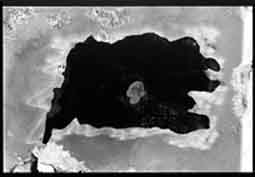
own amusement. Considerably more enigmatic are the photographs Cave
and Realiti. In the densely layered Cave, documents, a palm leaf, and fabric
encircle halfnaked women wearing pig masks. In Realiti, a plastic female
doll, whose physical features have been scratched by the artist into the
negative, is attacked by a rubber bat and dinosaur; all other details of
the image have been obliterated by the ar-tist's scratching away the emulsion
from the film.
Vető's photographs defy classification. His Still
Life is not still, but is constantly disappearing and re-emerging as the
eye focuses upon the different elements that it contains; its brushes fade
from view as the eye discovers the outlines of palm leaves. Realiti is
not reality; rather, it is a haphazardly constructed joke. Perhaps an oblique
reference to Plato's cave, the figures that emerge from the shadows of
Cave mock the viewer's search for meaning and reassurance in the photograph,
just as Black Could Flag, apparently a stain on film, transforms
the symbol of patriotic fervor to an abstract and useless form. By emphasizing
inchoate form, Vető's photographs seem to represent the dissolution of
reality and the laughable condition of those who continue to hold to it.
The photographs of Tibor Várnagy recall the experiments
of Russian Suprematist Kazimir Malevich at the turn of the century, and
the cameraless photographs of Moholy-Nagy. The Suprematist vision of Malevich
existed as a spiritual counterpoint to the revolutionary social vision
of the Russian Constructivists. (16) In con-trast to the Constructivists,
Malevich sought pure form in art, form as it emerges from raw material.
He believed that the depiction of things, the reproduction of nature, was
indicative of “cowardly consciousness and insolvency of creative power
in an artist.” “The square is a living, regal infant,” Malevich declared
in 1916. “The first step of pure creation in art.” (17)
The path charted by Malevich toward the purity of
form, toward the artist as a “null” freed from slavery to the obligations
of art, was profoundly influential to the young László Moholy-Nagy. Whereas
the pursuit of pure form was for Malevich an inquiry into human spirituality,
for Moholy-Nagy “religion simply did not exist.” (18) Moholy-Nagy believed
that art was “the activation of the energies of the subconscious through
the optical organ of the eye...the education of man's subconscious.” (19)
It was an educational process in which he saw photography playing a primary
role.
In the pursuit of pure form in photography, Moholy-Nagy
advocated the use of the cameraless photograph. “The photosensitive layer-plate
or paper-is a tabula rasa where we can sketch with light in the same way
that the painter works in a sovereign manner on the canvas with his own
instruments of paintbrush and pigment,” he wrote in 1928, in the publication
Bauhaus. “Whoever obtains a sense of writing with light by making photograms
without a camera, will be able to work in the most subtle way with a camera
as well.” (20) In his photograms, Moholy-Nagy demonstrated how photo-graphy
could accommodate the Suprematist experiments in pure form.
Várnagy's photographs combine Malevich's spiritual
quest with the technological consciousness of Moholy-Nagy. His Four
Black Squares and Fifth Black Square emerge from a devotion
to photographic experimentation and from his development of schnass. An
obscure word originally used by German guestworkers in Hungary to describe
the poverty of the Hungarians and their culture, schnass is the term used
by Várnagy to describe his practice of working exclusively with Hungarian
photographic materials, and eliciting from them their inherent qualities.
Underlying Várnagy's photographic experimentation
is a dialogue with Hungarian culture. In the series “Strabizmus”
(1986), for example, Várnagy used many small sheets of paper to create
a large image. The manufactured sheets were poorly cut, and when placed
together in a large rectangle gaps showed between them. The gaps became
an integral element in the overall work. In his Four Black Squares
and Fifth Black Square, Várnagy found his materials incapable of
yielding a perfect edge; light consistently permeated whatever borders
he constructed to inhibit it. This work acts at once as a return to the
spiritual quest of Malevich's Black Square, and as a poignant indicator
of the social and material poverty that necessitates such a quest.
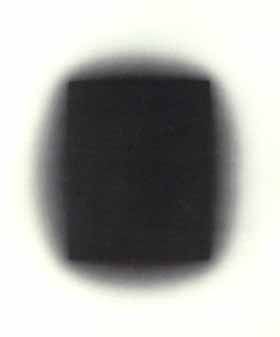
Tibor Várnagy: Black Square, 1988
In common with many other artists, Várnagy's photographs
are indicative of a departure from realism, the desire to divest objects
of meaning by denying the validity of their cultural functions. In his
work with cameraless photographs, Várnagy has been particularly successful.
His series of “TV Contacts,” made by holding pieces of photographic
paper against the television screen, transformed the everpresent features
of newscasters to pure form. Removing them from their context, from the
distrusted, Statecontrolled media, Várnagy effectively robbed the newscasters
of their role as the determiners of Hungarian reality and culture. His
work with a camera, distinguished by a marked decay of the image created
by reproducing the negative numerous times before printing, has accomplished
similar results by underscoring the role of the artist within Hungarian
cultural production.
“The group of suprematists. . . has waged the struggle
f or the liberation of objects from the obligations of art,” Malevich wrote
in 1916.(21) That struggle continues in the work of Várnagy, who recognizes
the only real liberation as spiritual. Only through such liberation will
the artist rediscover his relationship to the world of natural forms, from
which a new language can be constructed. Only through the emergence of
such a new language will the imposition of ideological values upon pure
form disappear from art, and a new Hungarian culture appear.
Today Hungary, with Poland, is charting the future
of Eastern European political and social life. The singleparty system is
opening up to embrace the plurality of voices that has always existed there.
The disappearance of borders, however, does not necessarily imply the arrival
of independence. More than most, Hungary's artists are aware of the encroaching
influence of the West. What they seek, as domination from the East fades
and the influence of the West beckons, is the rediscovery of their own
traditions and histories. In Hungary, language has always served as a uni-fying
factor, as that which distinguished Hungarian tradition and history from
the histories and traditions imposed upon the Hungarian people by the Turkish,
the Austrians, the Germans, and the Russians. To explore visual language,
to remove from it the remnants of dishonor and servitude and to uphold
in it that which has, somehow, retained its purity, is the goal of these
artists. By looking into themselves, by liberating form from ideological
domination, they are rewriting their own histories. In the work and spirit
of these artists, the language of independence is being born.
I have released all the birds from the eternal cage
and flung open the gates to the animals in the zoological gardens. May
they tear to bits and devour the leftovers of your art. (22)
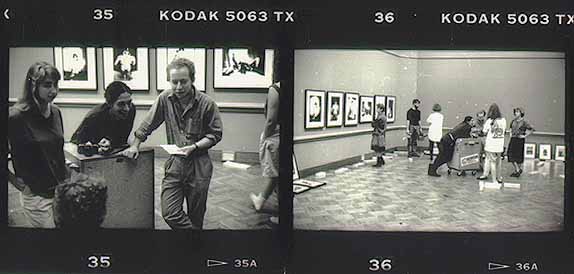
NOTES
1. Zoltan Halász, ed., Hungary: Geography, History, Political and
Social System, Economy, Living Standard, Sports, Budapest, 1963, p.
343.
2. Alexandr Rodchenko in Thinking Photography, ed. Victor Burgin,
London, 1982, p. 178.
3. Daniela Mrázková and Vladimir Remes, Early Soviet Photography,
Oxford, 1982, p. 9.
4. Ibid., p. 10.
5. John E. Bowlt, “Alexandr Rodchenko as Photographer,” in The
Avant-Garde in Russia, 1910-1930. New Perspectives, eds. Stephanie
Barron and Maurice Tuchman, Cambridge, Mass., 1980, p. 58.
6. John E. Bowlt, ed., Russian Art of the Avant-Garde: Theory and
Criticism, 1902-1934, New York, 1988, p. 291.
7. Peter A. Toma, Socialist Authority. The Hungarian Experience,
New York, 1988, p. 76.
8. Miklós Haraszti, The Velvet Prison. Artists under State Socialism,
New York, 1987, p. 100.
9. Ibid., p. 37. 10. Ibid.
11. Vaclaw Havel, A Besieged Culture. Czechoslovakia Ten Years after
Helsinki, Stockholm, 1985, p. 133.
12. László Beke, Expozició, Hatvan, Hungary, 1977, n.p.
13. Joseph Campbell, The Masks of God. Primitive Mythology,
New York, 1959, p. 139.
14. Gayle Rubin, “The Traffic in Women,” in Toward an Anthropology
of Women, ed. Rayna R. Reiter, New York, 1975, pp. 1S7-210.
15. Hans Peter Duerr, Dreamtime. Concerning the Boundary between
Wilderness and Civilization, New York, 1985, p. 43.
16. Michail Grosman, “About Malevich,” in The Avant-Garde
in Russia, 1910-1930, p. 25.
17. Kazimir Malevich, “From Cubism to Futurism to Suprematism: the
New Painterly Realism,” in Russian Art of the Avant Garde. Theory
and Criticism, p. 133.
18. Krisztina Passuth, Moholy-Nagy, New York, 1985, p. 25. 19.
Ibid., p. 319.
20. Ibid., p. 303.
21. Kazimir Malevich, “From Cubism and Futurism to Suprematism:
The New Painterly Realism” in Russian Art of the Avant-Garde:
Theory and Criticism, p. 135.
22. Ibid.